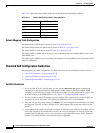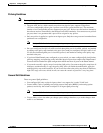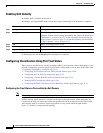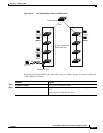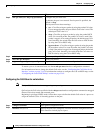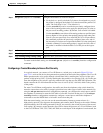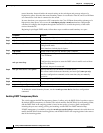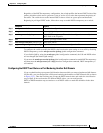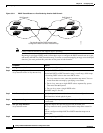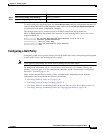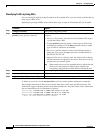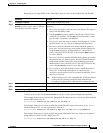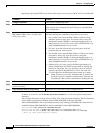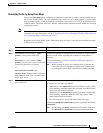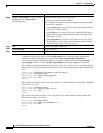
33-45
Catalyst 2960 and 2960-S Switch Software Configuration Guide
OL-8603-09
Chapter 33 Configuring QoS
Configuring Standard QoS
Regardless of the DSCP transparency configuration, the switch modifies the internal DSCP value of the
packet, which the switch uses to generate a class of service (CoS) value that represents the priority of
the traffic. The switch also uses the internal DSCP value to select an egress queue and threshold.
Beginning in privileged EXEC mode, follow these steps to enable DSCP transparency on a switch:
To configure the switch to modify the DSCP value based on the trust setting or on an ACL by disabling
DSCP transparency, use the mls qos rewrite ip dscp global configuration command.
If you disable QoS by using the no mls qos global configuration command, the CoS and DSCP values
are not changed (the default QoS setting).
If you enter the no mls qos rewrite ip dscp global configuration command to enable DSCP transparency
and then enter the mls qos trust [cos | dscp] interface configuration command, DSCP transparency is
still enabled.
Configuring the DSCP Trust State on a Port Bordering Another QoS Domain
If you are administering two separate QoS domains between which you want to implement QoS features
for IP traffic, you can configure the switch ports bordering the domains to a DSCP-trusted state as shown
in Figure 33-11. Then the receiving port accepts the DSCP-trusted value and avoids the classification
stage of QoS. If the two domains use different DSCP values, you can configure the
DSCP-to-DSCP-mutation map to translate a set of DSCP values to match the definition in the other
domain.
Command Purpose
Step 1
configure terminal Enter global configuration mode.
Step 2
mls qos Enable QoS globally.
Step 3
no mls qos rewrite ip dscp Enable DSCP transparency. The switch is configured to not modify the
DSCP field of the IP packet.
Step 4
end Return to privileged EXEC mode.
Step 5
show mls qos interface [interface-id] Verify your entries.
Step 6
copy running-config startup-config (Optional) Save your entries in the configuration file.




